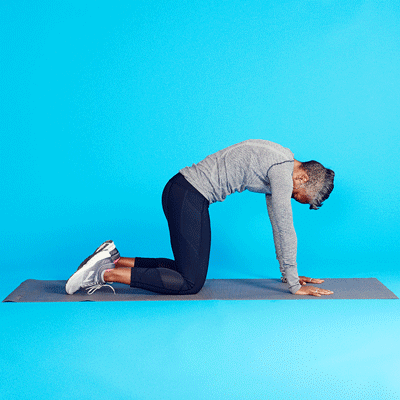Introduction

In this blog post we have to discuss 8 Lower Back Stretches to Reduce Pain and Mobility. Gradually, you may experience stiffness or soreness in your lower back which can interfere with some of your daily activities. To alleviate pain and improve movement of your body, some specific exercises can be very useful. In this post, I will share 8 targeted lower back stretching exercises that increase flexibility and decrease pain. By performing these stretches, you will help maintain the health of your spine and improve mobility.
The Science of Lower Back Pain
If the underlying reason for discomfort is well understood, and self-management strategies are in place, all patients can be provided with individual treatment plans focusing on managing lower back pain optimally. Pain due to an injury is often multifactorial, including spinal movement integration with musculature and nervous structures. Integrating the psychological factors aids in developing more effective control strategies for the pain.
Biomechanics Behind Lower Back Discomfort
In terms of construction, the upper body is supported as well as rotated by the lumbar region. Muscle imbalance can cause excess flexibility, as can overstretched postures and repetitive movements. Painful modified movement due to tight/weak muscles is possible. This makes injury more likely as an imbalanced muscle strength does. All forces acting on the spine as well as muscular encasement around it need to be neutralized to regain equilibrium as well as restore proper alignment to the spine.
Psychological Factors in Chronic Pain : Your mental state and processes most definitely affect the severity and intensity of pain you experience and how well you cope with it. Chronic lower back pain is often associated with stress and anxiety, as well as depression, and causes further aggravation due to this tension via a feedback cycle often referred to as tension-guarding. Following prolonged episodes of pain, your brain’s pain pathways may become sensitized. The aim is to lessen psychological suffering.
Emotionally charged stress tends to exacerbate inflammation present within delicate tissues.
Negative emotions escalate focus on pain signals.
Pain has been effectively treated with cognitive behavioral therapy.
The interaction between one’s mental state and physical body is very significant in pathology in relation to the chronic persistency of pain.
Additionally, positive coping strategies are a great psychological support that aids recovery, lessens pain intensity, and reduces overall pain duration. Mindfulness techniques, meditation, relaxation, and especially cognitive behavioral techniques serve to modulate the nervous systems that respond to pain and lower the level of pain signal amplification in the body.
Psychological treatment leads to decreased activity in the brain’s pain centers, according to neuroimaging studies. The importance of caring for mental health cannot be overemphasized as it is equally as crucial as physical rehabilitation to ensure relief from pain lasting over time.
Mature adaptive techniques can reshape the development of chronic pain.
Social relationships and support acts as a buffer toward pain-related disability.
Addressing mood disorders at stage one reduces the risk of developing chronic pain.
The combination of mental and physical health treatment improves the outcomes.
Flexibility Fundamentals: Why Stretching Matters
Stretching widens muscle tissues, however, it also increases the adaptability of your connective tissues as well as their ability to withstand strain. Regularly stretching your lower back helps tissue movement and circulation to stiff areas, allowing faster healing. These changes slow down the rate of muscle imbalance development, which tends to worsen pain, allowing for freer smoother movement, and less restricted movement during day to day activities.
Role of Flexibility in Pain Management
Improved flexibility reduces the tension of the bottom back, allowing a decrease in nerve compression and muscle spasms resulting in pain. When your muscles and ligaments are free to move fully, the cycle of pain due to tight and inflamed structures is broken. Research indicates the successful treatment of chronic pain in the lower back region with stretching exercises, reportedly ache relief of more than thirty percent.
Impact on Mobility and Everyday Activities
Having better flexibility enables you to move with less effort and tend to injuries, which improves your range of motion. Tasks like gardening or even comfortably sitting down for elongated periods become possible as your lower back becomes more resilient and less prone to strain. Better spinal mobility allows ease of movement and promotes better posture, helps in alleviating fatigue, and encourages the person to lead an active life.
Talking about lower back flexibility, it improves mobility of joints which allows easier movement and as a consequence, encourages a more active lifestyle. Enhanced spinal mobility particularly allows older adults to nbsp. Reduced capacity to maintain and change position decreases fall risk, better balance, and faster reaction times improve overall stability. Moreover, joints that are moved through activities using well flexible muscles tend to have decreased wear and tear, reducing the chances of joint degeneration, retaining joint longevity, or decreasing pain over time.
Stretching Techniques: The Eight Essentials
The following are 8 Lower Back Stretches Each of these eight stretches aims at improving mobility, dealing with pain, improving pain condition, and ache caused due to different supporting muscles of lower back. These eight important spells performed consistently will help maintain proper spinal alignment. Stretching helps ensures both muscle activation and relaxation, promoting both pain relief and long-term health.
The Cat-Cow Stretch

Position yourself on all fours, synchronize your breath as you arch your back upward and dip it downward. The movement and breath coordination eases stiffness and improves circulation to the area by mobilizing your spine and warming up the muscles around your lower back.
Child’s Pose
Bring your torso to the floor, spread your arms out, and sit back on your feet. Stretch your lower back and hips out a little. As you do this, a lot of stress around the hips will release. It will also decompress the spine and stretch out tight muscles.
To get even better at Child’s Pose, keep your arms out in front of you and sink your chest to the floor. You can also spread your knees apart to make the release in your hips even stronger. If you hold these poses for 30 seconds to one minute, they help your nervous system relax, which can ease chronic pain.
Seated Forward Bend
While sitting, stretch your legs out and reach for your toes by hingeing at the hips. This makes the muscles in your lower back and hamstrings less tight and increases the flexibility of your lower back.
When you hinge forward at the hips and fold forward, make sure to keep your back straight. If you need help and can’t bend your legs or feet very far, a strap around your feet can help. You will be able to move around easily without tense lower back if you work at it and keep at it.
Piriformis Stretch
Cross one leg over the other while you’re on your back. Slowly pull the leg that isn’t crossed up to your chest. This move hits the piriformis muscle directly, which can put pressure on the sciatic nerve and cause lower back pain.
If you want to get the most out of the stretch, keep your head and shoulders flat on the ground. If you have long-lasting sciatica pain, staying in this pose for a while can help ease nerve irritability and make it easier to move.
Supine Spinal Twist
While lying on your back, bend one knee across your body while keeping the rest of your body flat. This gentle motion helps mobilize the spine while keeping it in a fixed position as well as stretching the muscles surrounding your lower back which improves the flexibility of the spine.
Make sure to tighten your core a little when twisting to protect your spine while safely increasing the stretch. Regularly practicing this twist helps counteract the ill effects of sitting for long durations which leads to stiff lower back muscles.
Knee-to-Chest Stretch
Pulling one or both knees to the chest while lying supine can help to decompress the lumbar spine and relieve hypertonic muscles due to prolonged sitting or slumping. This is a very good starting exercise for alleviating tension in the lower back.
By maintaining contact of the lower back with the floor the stretch becomes deeper and encourages spinal alignment. This stretch can also be beneficial after exercise in alleviating muscle soreness and recovering.
Standing Hamstring Stretch
The forward lean with a hamstring stretch performed while standing is using a heel placed on a low surface. The hamstrings, which often exert a pull on the pelvis and pelvis, are stretched. Enhancing flexibility in the hamstrings may reduce the excessive pressure on the lower back.
To prevent hyperextension of the knee, a slight bend in the standing leg is required. Muscle relaxation is essential to maintain a healthy spine, and regular bends stretches the hamstrings, supporting balanced muscle tension.
Pelvic Tilt
While in supine lying position with one’s knees bent, the abdominal muscles are contracted to achieve a flat lower back. These movements are controlled and works in strengthening the core, assisting relieving lower back pressure through proper pelvic alignment.
Slow belly contractions are great for deep core muscles engagement. This will enable functioning foundational muscle movement through the growing core strength, targeted in the pelvic tilt, shielding the lower back from excess strain during routine activities.
Optimal Timing and Frequency for Stretching
Stretching your lower back on a regular basis improves flexibility and helps to relieve pain. Usually, the results are quite good from performing a 10 -15 min routine three to four times a week. Each person is different, the muscle and soft tissue respond to certain stimulus at different times of the day. Though stretches do offer a lot, to reap excess benefits might overdo it injuring the muscle instead of strengthening it. Adapt the regimen according to your self assessment during the day.
Best Times to Incorporate Stretches
Additionally, incorporating short Break Strain Stretches (BSS) during long sedentary activities, like sitting at your desk for a couple of hours, significantly helps in restricting pain build up within the body. Lastly, post-workout stretching encourages muscle relaxation and eases the recovery process.
Routine Practices Versus On-Demand Practices
A set schedule preconditions the muscles and joints to withstand the stressors of everyday life which improves the overall productivity.
With that, daily stretching allows you to create an attack plan against recurring issues while those punches in the gut build up to add if you forget to hold these ranges of motion.The blend approach of dainty stretches, applying at an extreme, defines, adds self-control to the loaded springs that eases in concise motion aids through self-control.
Avoiding Common Stretching Mistakes
Stretching efficiently begins with understanding that there’s more to lower back recovery than simply going through the motions. Most individuals seem to unintentionally work against themselves, either by overexerting themselves, or not trying hard enough. These cycles have the potential to make matters worse rather than easier. Listening to how the body communicates to you during stretches and adhering to a discipline aids mobility whilst ensuring it does not worsen the pain. Avoiding stretching mishaps allows you to enjoy the long term effects of stretches while preventing preventable delays in healing.
Overstretching: Recognizing Limits
“Overstretching” is how far you are willing to push yourself beyond your lower back without inflicting damage to the already hurting muscle or worsening existing problems. A stretch will never feel like more than a soft drag.
Inconsistent Practice: The Commitment Factor
The lower back muscles respond well to movements done on a daily basis, or at least every other day, because the actions help in muscle memory formation and increase blood flow. If there isn’t enough frequency to achieve meaningful results, stretching one or two times a week may lead to pain or hindered mobility which can be exasperating.
Unlocking the managing of lower back discomfort lies in the pendant of maintaining consistency. Individuals who follow a stretching routine of 4-5 times a week have shown considerable reduction in lower back pain, and increase in range of motion within a few weeks. Creating specific habits like stretching first thing in the morning or last thing at night makes this regimen easily adaptable.
Conclusion
The 8 Lower Back Stretches That Actually Work for Pain and Mobility, you can see that these exercises not only help with pain but also make you more flexible. If you do these moves often, they can help keep your back and knees healthy. They will help you deal with lower back pain better and heal faster over time if you do them every day. Pain can make your daily life harder and make it harder to move around. Getting rid of pain will help you feel stronger when you work out.
FAQ
1. One, what is the purpose of Lower Back Stretches?
If you suffer from stiffness, soreness, or a lack of flexibility in your lower back, these stretches may assist. You might avoid back problems with their assistance.
2. What frequency is recommended for Lower Back Stretches?
Flex your lower back three to five times a week if you’re feeling a little tightness or stiffness. To see if it makes a difference, try stretching daily.
3. Which lower back stretches help the most with pain relief?
For lower back stretching, try the Cat-Cow, Child’s Pose, Knee-to-Chest, and Seated Spinal Twist positions. Their flexibility and suppleness are also enhanced.
4. Is it possible to alleviate sciatica pain with Lower Back Stretches?
A pinched sciatic nerve can cause leg pain; a gentle back extension may alleviate some of the pain.
5. For eachLower Back Stretches, how many counts should you maintain?
The most effective way to stretch your lower back is to hold each position for 20 to 30 seconds and repeat the process two or three times on each side.
6. Is there a safe way to Lower Back Stretches anyone?
Lower back stretches are generally safe for most individuals, but those who are very ill, hurt, or in pain should consult a medical professional before doing them.
7. Would extending your lLower Back Stretches help you stand up straighter?
Daily lower back exercises will help you stand taller, loosen out those knots in your muscles, and align your spine.
Similar osts
- Active Living
- 4 Best Exercises for Health
- 15 Pilates Exercises for Beginners: A Gentle Start to Core Strength and Flexibility
- 4 Holistic Approaches to Managing Chronic Pain: A Comprehensive Guide
- 6 Home Exercises for Overall Fitness and Flexibility: A Comprehensive Guide
- How to Stay Active While Working from Home: A Comprehensive Guide
